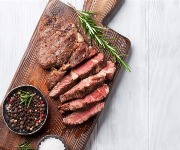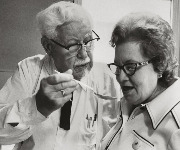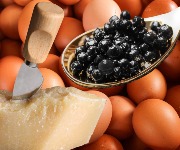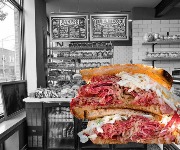How to smoke food in a filing cabinet
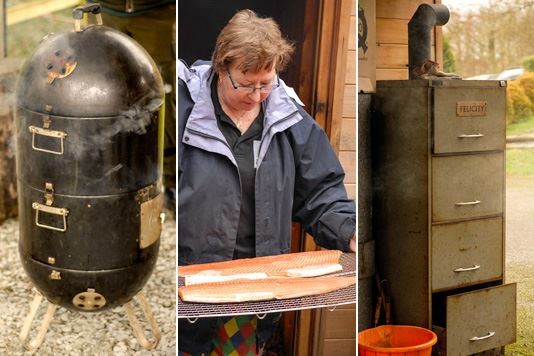
Jane Hughes discovers the world of DIY smoking and the resurgence in popularity of this deceptively easy cooking method.

I thought I could handle it. But as soon as the first tendrils of smoke curled into the air, I was hooked. 'Smoky Jo' had promised to teach me to smoke and I couldn't wait to try it. In case you're confused, Smoky Jo doesn't teach people to smoke cigarettes... she teaches them to smoke food.
I'm not the only one with a new habit. All over the country, people are doing it in sheds, wardrobes and filing cabinets. They’re even making smoking boxes out of hi-fi cabinets.
The good ol' days

In the past, smoking was a means of preserving food. Both salting and smoking food help to dry it out, making it much harder for harmful bacteria to multiply and spoil the food. But the resurgence of interest in home-smoking has more to do with the taste, plus a new-found collective desire to understand more about what we eat.
Smoking may sound like a technical undertaking, but it's actually more of an art than a science. And although you might eventually be dedicated enough to build an artisan smokehouse to serve your community, beginners can easily get started with inexpensive equipment.
DIY enthusiasts can have endless fun devising Heath Robinson-style contraptions. That's where the filing cabinet comes in. Stick a chimney on it, smoke a handful of wood dust in the bottom drawer, and put food in the top drawer. It's easy!
Hot and cold smoking
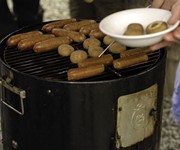
What's the difference between 'hot smoking' and 'cold smoking'? Well, hot smoking gets your food hot. It cooks your food, and is a faster process than cold smoking, which exposes food to a source of wood smoke but not to a source of heat. Cold smoking tends to push flavour into food whereas hot smoking tends to deposit flavour on the surface.
Cold smoking can be done in a customised cardboard box and is the method of choice for things like: cheese, which tends to melt in a hot smoker (although halloumi can be hot-smoked); fruit (which otherwise turns to mush); and tofu, which needs time to absorb the flavour.
 On a day-long course with Smoky Jo (aka Jo Hampson of Smoky Jo's) at the gorgeous Wild Boar Inn in the hills above Windermere (one of many fantastic 'Great Inns of Britain'), we smoked the usual chicken, salmon, trout and ham. However, we also smoked almonds and cashews, boiled eggs, cheeses, garlic, mushrooms, and a packet of ready-made vegetarian sausages which were greatly improved by the process! Jo told me that she has even smoked packets of dried nut roast mix before. She is currently experimenting with smoking flour, and recently snapped up an award for her home-made marmalade, made with smoked oranges.
On a day-long course with Smoky Jo (aka Jo Hampson of Smoky Jo's) at the gorgeous Wild Boar Inn in the hills above Windermere (one of many fantastic 'Great Inns of Britain'), we smoked the usual chicken, salmon, trout and ham. However, we also smoked almonds and cashews, boiled eggs, cheeses, garlic, mushrooms, and a packet of ready-made vegetarian sausages which were greatly improved by the process! Jo told me that she has even smoked packets of dried nut roast mix before. She is currently experimenting with smoking flour, and recently snapped up an award for her home-made marmalade, made with smoked oranges.
Soaking and smoking
 The day-long course begins with a quick introduction to the theory, but it's not long before you find yourself rummaging in the restaurant's well-stocked kitchen for spices to customise your brine mixture.
The day-long course begins with a quick introduction to the theory, but it's not long before you find yourself rummaging in the restaurant's well-stocked kitchen for spices to customise your brine mixture.
Soaking the food in salt water first helps draw the smoke into the food and, odd though it may seem, actually helps dry out the food and gives it a longer shelf life. Different foods require different brining times, from half an hour to overnight, and those in the know take the opportunity to pack in extra flavour by adding herbs and spices to the salty mixture. Jo and her partner Smoky Georgina provided all sorts of vegetarian foods for me to experiment with, much to the interest, and even envy, of other participants on the course.
Once our food was properly prepared, we headed out into the drizzle to discover an array of smoking apparatus, ranging from the hotel's own beautiful smokehouse (a perfect complement to their microbrewery) to a variety of commercial smokers and several home-made ones, including a filing cabinet called Felicity.
Having stacked our various offerings in the smokers, we trooped back indoors, pausing at the bar to sample smoked gin and Bloody Marys (made with smoked tomatoes). More marinating, soaking and rinsing followed, and despite the hotel's generous provision of pastries we were all ravenous by the time lunch was served. It was a feast of smoked delicacies with big bowls of buttery new potatoes and salads. My hot-smoked halloumi marinated in the hotel's home-made marmalade was subject to much admiration.
Everything in moderation
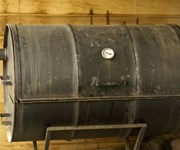 Salt and smoke are natural partners. But there are health issues attached to them both, and smoked food is best enjoyed as an occasional treat. It's hard to resist smoking absolutely everything in sight once the smoke starts rising, but you don't have to eat it all at once. The process helps to preserve food and of course you can freeze what you have prepared, or use it in other cooked dishes and then store those for another time. Imagine a moussaka made with smoked aubergines, or a rich pate made with smoked beans and garlic...
Salt and smoke are natural partners. But there are health issues attached to them both, and smoked food is best enjoyed as an occasional treat. It's hard to resist smoking absolutely everything in sight once the smoke starts rising, but you don't have to eat it all at once. The process helps to preserve food and of course you can freeze what you have prepared, or use it in other cooked dishes and then store those for another time. Imagine a moussaka made with smoked aubergines, or a rich pate made with smoked beans and garlic...
After a smoky lunch and a sumptuous smoked evening banquet, everybody's taste buds were in a state of shock and some of us might not experience the urge to eat anything smoked for a while! But after just one day of smoking, I'm willing to bet that at least some of us are itching to do it all over again.
The next courses with Smoky Jo at the Wild Boar are on 7th May, 9th July and 10th September 2014.
You might also like
Most Recent
Comments
Be the first to comment
Do you want to comment on this article? You need to be signed in for this feature
